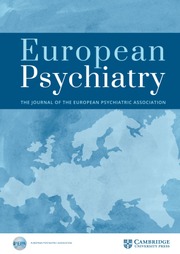Crossref Citations
This article has been cited by the following publications. This list is generated based on data provided by
Crossref.
Lee, Deokjong
Lee, Junghan
Namkoong, Kee
and
Jung, Young-Chul
2018.
Subregions of the Anterior Cingulate Cortex Form Distinct Functional Connectivity Patterns in Young Males With Internet Gaming Disorder With Comorbid Depression.
Frontiers in Psychiatry,
Vol. 9,
Issue. ,
Darnai, Gergely
Perlaki, Gábor
Zsidó, András N.
Inhóf, Orsolya
Orsi, Gergely
Horváth, Réka
Nagy, Szilvia Anett
Lábadi, Beatrix
Tényi, Dalma
Kovács, Norbert
Dóczi, Tamás
Demetrovics, Zsolt
and
Janszky, József
2019.
Internet addiction and functional brain networks: task-related fMRI study.
Scientific Reports,
Vol. 9,
Issue. 1,
Uniacke, Blair
Wang, Yun
Biezonski, Dominik
Sussman, Tamara
Lee, Seonjoo
Posner, Jonathan
and
Steinglass, Joanna
2019.
Resting‐state connectivity within and across neural circuits in anorexia nervosa.
Brain and Behavior,
Vol. 9,
Issue. 1,
Chun, Ji-Won
Park, Chang-Hyun
Kim, Jin-Young
Choi, Jihye
Cho, Hyun
Jung, Dong Jin
Ahn, Kook-Jin
Choi, Jung-Seok
Kim, Dai-Jin
and
Choi, In Young
2020.
Altered core networks of brain connectivity and personality traits in internet gaming disorder.
Journal of Behavioral Addictions,
Vol. 9,
Issue. 2,
p.
298.
Hung, Chia-Chun
Liu, Yi-Hsuan
Huang, Chu-Chung
Chou, Cheng-Ying
Chen, Chun-Ming
Duann, Jeng-Ren
Li, Chiang-Shan R.
Lee, Tony Szu-Hsien
and
Lin, Ching-Po
2020.
Effects of early ketamine exposure on cerebral gray matter volume and functional connectivity.
Scientific Reports,
Vol. 10,
Issue. 1,
Su, Hang
Liu, Yilin
Yin, Dazhi
Chen, Tianzhen
Li, Xiaotong
Zhong, Na
Jiang, Haifeng
Wang, Jijun
Du, Jiang
Xiao, Ke
Xu, Ding
Zeljic, Kristina
Wang, Zheng
and
Zhao, Min
2020.
Neuroplastic changes in resting-state functional connectivity after rTMS intervention for methamphetamine craving.
Neuropharmacology,
Vol. 175,
Issue. ,
p.
108177.
Moradi, Mahdi
Ekhtiari, Hamed
Kuplicki, Rayus
McKinney, Brett
Stewart, Jennifer L.
Victor, Teresa A.
and
Paulus, Martin P.
2020.
Evaluating the resource allocation index as a potential fMRI-based biomarker for substance use disorder.
Drug and Alcohol Dependence,
Vol. 216,
Issue. ,
p.
108211.
Gentili, Claudio
Vanello, Nicola
Podina, Ioana
Popita, Raluca
Voinescu, Bogdan
Pietrini, Pietro
and
David, Daniel
2020.
You do not have to act to be impulsive: Brain resting-state activity predicts performance and impulsivity on the Balloon Analogue Risk Task.
Behavioural Brain Research,
Vol. 379,
Issue. ,
p.
112395.
Dong, Guang-Heng
Wang, Ziliang
Dong, Haohao
Wang, Min
Zheng, Yanbin
Ye, Shuer
Zhang, Jialin
and
Potenza, Marc N.
2020.
More stringent criteria are needed for diagnosing internet gaming disorder: Evidence from regional brain features and whole-brain functional connectivity multivariate pattern analyses.
Journal of Behavioral Addictions,
Vol. 9,
Issue. 3,
p.
642.
Ahn, Jaeun
Lee, Deokjong
Namkoong, Kee
and
Jung, Young-Chul
2021.
Altered Functional Connectivity of the Salience Network in Problematic Smartphone Users.
Frontiers in Psychiatry,
Vol. 12,
Issue. ,
Yüncü, Zeki
Cakmak Celik, Zehra
Colak, Ciğdem
Thapa, Tribikram
Fornito, Alex
Bora, Emre
Kitis, Omer
and
Zorlu, Nabi
2021.
Resting state functional connectivity in adolescent synthetic cannabinoid users with and without attention‐deficit/hyperactivity disorder.
Human Psychopharmacology: Clinical and Experimental,
Vol. 36,
Issue. 5,
Ke, Ming
Li, Jianpan
and
Wang, Lubin
2021.
Alteration in Resting-State EEG Microstates Following 24 Hours of Total Sleep Deprivation in Healthy Young Male Subjects.
Frontiers in Human Neuroscience,
Vol. 15,
Issue. ,
Akama, Hiroyuki
Yuan, Yixin
and
Awazu, Shunji
2021.
Task‐induced brain functional connectivity as a representation of schema for mediating unsupervised and supervised learning dynamics in language acquisition.
Brain and Behavior,
Vol. 11,
Issue. 6,
Chen, Jiajie
Wang, Fan
Zhu, Jia
Li, Yongbin
Liu, Wei
Xue, Jiuhua
Shi, Hong
Li, Wei
Li, Qiang
and
Wang, Wei
2021.
Assessing effect of long‐term abstinence on coupling of three core brain networks in male heroin addicts: A resting‐state functional magnetic resonance imaging study.
Addiction Biology,
Vol. 26,
Issue. 4,
Zhou, Wei-ran
Wang, Min
Zheng, Hui
Wang, Meng-jing
and
Dong, Guang-Heng
2021.
Altered modular segregation of brain networks during the cue-craving task contributes to the disrupted executive functions in internet gaming disorder.
Progress in Neuro-Psychopharmacology and Biological Psychiatry,
Vol. 107,
Issue. ,
p.
110256.
Yan, Haijiang
Li, Qi
Yu, Kai
and
Zhao, Guozhen
2021.
Large-scale network dysfunction in youths with Internet gaming disorder: a meta-analysis of resting-state functional connectivity studies.
Progress in Neuro-Psychopharmacology and Biological Psychiatry,
Vol. 109,
Issue. ,
p.
110242.
Zhang, Jialin
Chen, Shuaiyu
Jiang, Qing
Dong, Haohao
Zhao, Zhen
Du, Xiaoxia
and
Dong, Guang-Heng
2021.
Disturbed craving regulation to gaming cues in internet gaming disorder: Implications for uncontrolled gaming behaviors.
Journal of Psychiatric Research,
Vol. 140,
Issue. ,
p.
250.
Song, Kun‐Ru
Potenza, Marc N.
Fang, Xiao‐Yi
Gong, Gao‐Lang
Yao, Yuan‐Wei
Wang, Zi‐Liang
Liu, Lu
Ma, Shan‐Shan
Xia, Cui‐Cui
Lan, Jing
Deng, Lin‐Yuan
Wu, Lu‐Lu
and
Zhang, Jin‐Tao
2021.
Resting‐state connectome‐based support‐vector‐machine predictive modeling of internet gaming disorder.
Addiction Biology,
Vol. 26,
Issue. 4,
Patil, Abhishek Uday
Madathil, Deepa
and
Huang, Chih‐Mao
2021.
Age‐related and individual variations in altered prefrontal and cerebellar connectivity associated with the tendency of developing internet addiction.
Human Brain Mapping,
Vol. 42,
Issue. 14,
p.
4525.
Liu, Lu
Potenza, Marc N.
Lacadie, Cheryl M.
Zhang, Jin‐Tao
Yip, Sarah W.
Xia, Cui‐Cui
Lan, Jing
Yao, Yuan‐Wei
Deng, Lin‐Yuan
Park, Soyoung Q.
and
Fang, Xiao‐Yi
2021.
Altered intrinsic connectivity distribution in internet gaming disorder and its associations with psychotherapy treatment outcomes.
Addiction Biology,
Vol. 26,
Issue. 2,



Comments
No Comments have been published for this article.